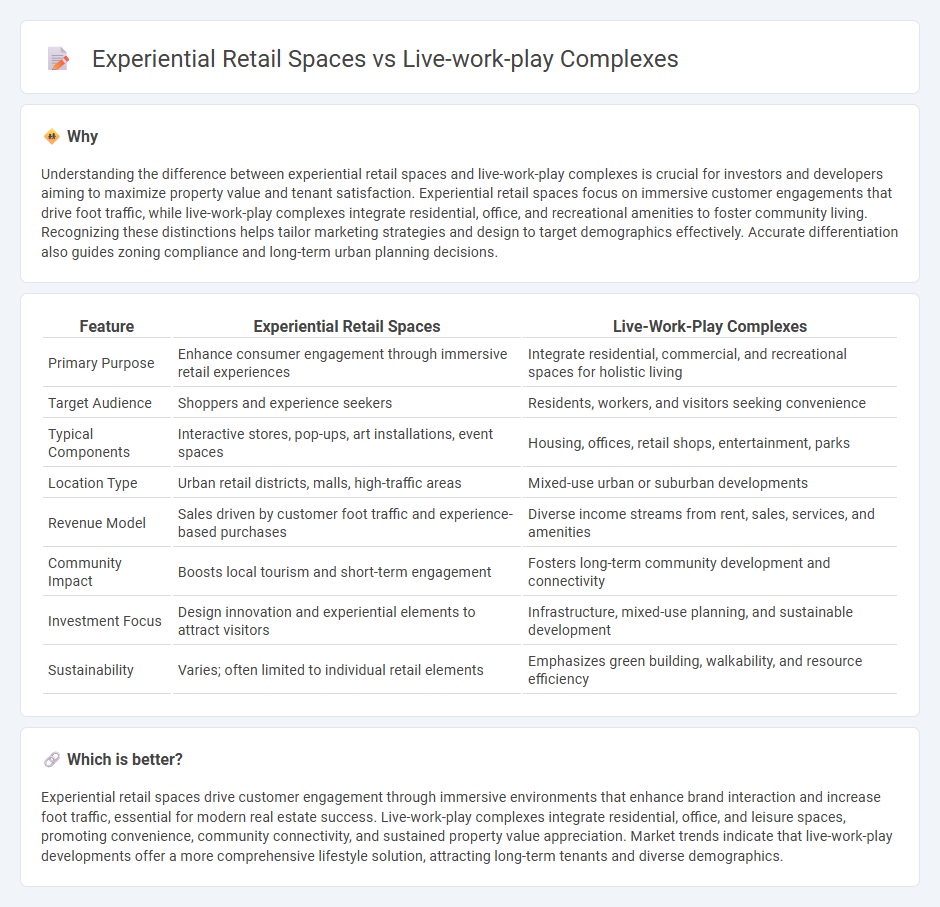
Experiential retail spaces focus on interactive, immersive shopping experiences that engage customers beyond traditional retail, often incorporating technology and entertainment elements. Live-work-play complexes integrate residential, office, and recreational facilities within a single development, promoting convenience and community connectivity. Explore the evolving trends of real estate that blend lifestyle and commerce for innovative urban living.
Why it is important
Understanding the difference between experiential retail spaces and live-work-play complexes is crucial for investors and developers aiming to maximize property value and tenant satisfaction. Experiential retail spaces focus on immersive customer engagements that drive foot traffic, while live-work-play complexes integrate residential, office, and recreational amenities to foster community living. Recognizing these distinctions helps tailor marketing strategies and design to target demographics effectively. Accurate differentiation also guides zoning compliance and long-term urban planning decisions.
Comparison Table
| Feature | Experiential Retail Spaces | Live-Work-Play Complexes |
|---|---|---|
| Primary Purpose | Enhance consumer engagement through immersive retail experiences | Integrate residential, commercial, and recreational spaces for holistic living |
| Target Audience | Shoppers and experience seekers | Residents, workers, and visitors seeking convenience |
| Typical Components | Interactive stores, pop-ups, art installations, event spaces | Housing, offices, retail shops, entertainment, parks |
| Location Type | Urban retail districts, malls, high-traffic areas | Mixed-use urban or suburban developments |
| Revenue Model | Sales driven by customer foot traffic and experience-based purchases | Diverse income streams from rent, sales, services, and amenities |
| Community Impact | Boosts local tourism and short-term engagement | Fosters long-term community development and connectivity |
| Investment Focus | Design innovation and experiential elements to attract visitors | Infrastructure, mixed-use planning, and sustainable development |
| Sustainability | Varies; often limited to individual retail elements | Emphasizes green building, walkability, and resource efficiency |
Which is better?
Experiential retail spaces drive customer engagement through immersive environments that enhance brand interaction and increase foot traffic, essential for modern real estate success. Live-work-play complexes integrate residential, office, and leisure spaces, promoting convenience, community connectivity, and sustained property value appreciation. Market trends indicate that live-work-play developments offer a more comprehensive lifestyle solution, attracting long-term tenants and diverse demographics.
Connection
Experiential retail spaces enhance consumer engagement by offering interactive environments, which complement live-work-play complexes designed for integrated urban lifestyles. Both concepts prioritize creating dynamic, multifunctional areas that blend residential, commercial, and leisure activities, boosting property values and attracting diverse demographics. This synergy fosters community connectivity and supports sustainable economic growth in real estate developments.
Key Terms
**Live-work-play complexes:**
Live-work-play complexes integrate residential, commercial, and recreational spaces into cohesive, multifunctional environments designed to enhance convenience and community engagement. These complexes promote sustainable urban living by reducing commute times and encouraging social interaction through shared public areas and amenities. Explore how live-work-play developments are transforming modern lifestyle trends and urban design strategies.
Mixed-use development
Mixed-use developments integrate live-work-play complexes by combining residential, commercial, and recreational spaces to foster community engagement and economic vitality. Experiential retail spaces emphasize interactive, immersive shopping experiences, often within mixed-use environments to enhance foot traffic and consumer satisfaction. Explore how these innovative urban planning approaches transform lifestyle and commerce by blending functionality and experience.
Walkability
Live-work-play complexes integrate residential, office, and entertainment spaces to enhance walkability, reducing reliance on vehicles and fostering community engagement. Experiential retail spaces prioritize interactive and immersive shopping experiences but may require strategic placement to ensure pedestrian access and convenience. Explore how walkability shapes urban design to create vibrant, sustainable environments.
Source and External Links
Live-Work-Play Communities: Challenges and Opportunities in Development - This article explores the concept and components of live-work-play communities, focusing on their integration of residential, commercial, and recreational spaces.
What Developers Should Know About Live Work Play Communities - The article provides insights into the development of live-work-play communities, highlighting essential components such as residential, employment opportunities, and lifestyle amenities.
Office buildings become live-work-play communities - This guide discusses the transformation of office buildings into live-work-play communities, outlining challenges and strategies for successful property management.
 dowidth.com
dowidth.com